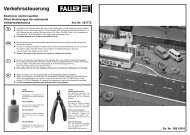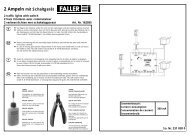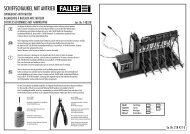INSTRUCTION MANUAL
INSTRUCTION MANUAL
INSTRUCTION MANUAL
Create successful ePaper yourself
Turn your PDF publications into a flip-book with our unique Google optimized e-Paper software.
Decoder MX620 - MX622, MX630 - MX632 Sound Decoder MX640 - MX648 Page 15<br />
3.5 Analog operation<br />
All ZIMO decoders are capable of operating on conventional layouts with DC power packs, including<br />
PWM throttles, in analog DC as well as in analog AC (Marklin transformers with high voltage pulse for<br />
direction change).<br />
To allow analog operation<br />
CV #29, Bit 2 = 1<br />
must be set. This is usually the case by default (CV #29 = 14, which includes Bit 2 = 1), but analog operation<br />
may be turned off in many sound projects (sound decoders).<br />
The actual behavior during analog operation, however, is strongly influenced by the locomotive controller<br />
(power pack). Especially in conjunction with a weak transformer, it is easily possible that the<br />
track voltage collapses when the decoder (motor) starts to draw power which, in the worst case, may<br />
lead to intermittent performance.<br />
There are some adjustment possibilities for analog operation where motor control and function outputs<br />
are concerned; these CV’s can of course be read-out or programmed only with a DCC system<br />
or other programming device.<br />
CV Designation Range Default Description<br />
#29<br />
#13<br />
Basic configuration<br />
Functions F1 – F8 in<br />
analog mode<br />
0 - 63<br />
14 =<br />
0000 1110<br />
includes<br />
Bit 2 = 1<br />
(Analog<br />
operation<br />
enabled)<br />
0 - 255 0<br />
Bit 0 - Train direction:<br />
0 = normal, 1 = reversed<br />
Bit 1 - Number of speed steps:<br />
0 = 14, 1 = 28<br />
Bit 2 – Automatic switchover to analog:<br />
0 = disabled 1 = enabled<br />
Bit 3 - RailCom („bidirectional communication“)<br />
0 = deactivated 1 = activated<br />
Bit 4 - Individual speed table:<br />
0 = off, CV # 2, 5 and 6 are active.<br />
1 = on, according to CV ‘s # 67 – 94<br />
Bit 5 - Decoder address:<br />
0 = primary address as per CV #1<br />
1 = ext. address as per CV #17+18<br />
Select functions that should be ON in analog operation.<br />
Bit 0 = 0: F1 OFF in analog mode<br />
= 1: …ON…<br />
Bit 1 = 0: F2 OFF in analog mode<br />
= 1: …ON…<br />
………. F3, F4, F5, F6, F7<br />
Bit 7 = 0: F8 OFF in analog mode<br />
= 1: …ON…<br />
Select functions that should be ON in analog operation.<br />
Bit 0 = 0: F0 (forw.) OFF in analog mode<br />
= 1: …ON…<br />
Bit 1 = 0: F0 (rev.) OFF in analog mode<br />
= 1: …ON…<br />
Bit 2 = 0: F9 OFF in analog mode<br />
= 1: …ON…<br />
………. F10, F11<br />
Bit 5 = 0: F12 OFF in analog mode<br />
= 1: …ON…<br />
Bit 6 = 0: Analog operation with momentum as per<br />
CV’s #3 + 4; often needed for sound<br />
= 1: Analog operation without momentum from<br />
CV #3 + 4; immediate response to track<br />
voltage similar to classic analog control.<br />
Bit 7 = 0: Analog operation without motor regulation.<br />
= 1: Analog operation with motor regulation.<br />
#14<br />
Functions F0<br />
(forward, reverse) and<br />
F9 – F12<br />
in analog mode<br />
and<br />
acceleration,<br />
deceleration and motor<br />
control in analog<br />
0 - 255<br />
64<br />
that is<br />
Bit 6 = 1<br />
Note: A decoder may have different settings than the default values, due to an installed sound project.<br />
This is especially true for motor regulation (CV #14, Bit 7), which is often enabled by the sound project.<br />
The regulation only works well with power packs that apply “clean” DC voltage (i.e. with an LGB 50<br />
080); it is better to turn the motor regulation off if the track voltage is not properly rectified or consists of<br />
half-wave signals.










